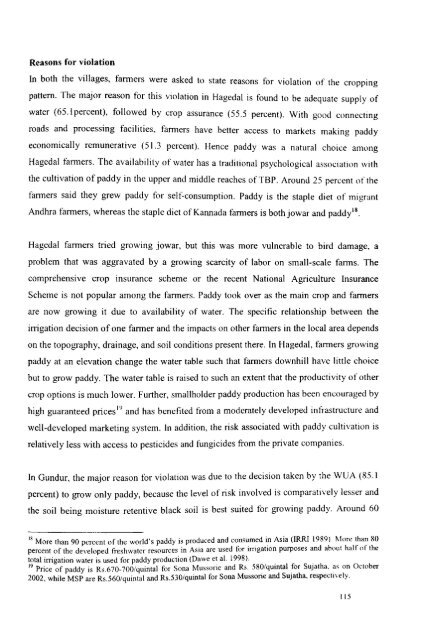Water Users Association and Irrigation Management - Institute for ...
Water Users Association and Irrigation Management - Institute for ...
Water Users Association and Irrigation Management - Institute for ...
Create successful ePaper yourself
Turn your PDF publications into a flip-book with our unique Google optimized e-Paper software.
Reasons <strong>for</strong> violation<br />
In both the villages, fanners were asked to state reasons <strong>for</strong> violation of the cropping<br />
pattern. The major reason <strong>for</strong> this violation in Hagedal is found to be adequate supply of<br />
water (65.lpercent), followed by crop assurance (55.5 percent). With good connecting<br />
roads <strong>and</strong> processing facilities, fanners have better access to markets making paddy<br />
economically remunerative (51.3 percent). Hence paddy was a natural choice among<br />
Hagedal fanners. The availability of water has a traditional psychological association with<br />
the cultivation of paddy in the upper <strong>and</strong> middle reaches of TBP. Around 25 percent of the<br />
fanners said they grew paddy <strong>for</strong> self-consumption. Paddy is the staple diet of migrant<br />
Andhra fanners, whereas the staple diet of Kannada farmers is both jowar <strong>and</strong> paddyl8.<br />
Hagedal fanners tried growmg Jowar, but this was more vulnerable to bird damage, a<br />
problem that was aggravated by a growing scarcity of labor on small-scale fanns. The<br />
comprehensive crop insurance scheme or the recent National Agriculture Insurance<br />
Scheme is not popular among the farmers. Paddy took over as the main crop <strong>and</strong> farmers<br />
are now growing it due to availability of water. The specific relationship between the<br />
irrigation decision of one fanner <strong>and</strong> the impacts on other farmers in the local area depends<br />
on the topography, drainage, <strong>and</strong> soil conditions present there. In Hagedal, farmers growing<br />
paddy at an elevation change the water table such that farmers downhill have little choice<br />
but to grow paddy. The water table is raised to such an extent that the productivity of other<br />
crop options is much lower. Further, smallholder paddy production has been encouraged by<br />
high guaranteed prices 19 <strong>and</strong> has benefited from a moderately developed infrastructure <strong>and</strong><br />
well-developed marketing system. In addition, the risk associated with paddy cultivation is<br />
relatively less with access to pesticides <strong>and</strong> fungicides from the private companies.<br />
In Gundur, the major reason <strong>for</strong> violation was due to the decision taken by the WUA (85.1<br />
percent) to grow only paddy, because the level of risk involved is comparatively lesser <strong>and</strong><br />
the soil being moisture retentive black soil is best suited <strong>for</strong> growing paddy. Around 60<br />
18 More than 90 percent of the world's paddy is produced <strong>and</strong> consumed in Asia (lRRl (989) More than 80<br />
percent of the developed freshwater resources in Asia are used <strong>for</strong> irrigation purposes <strong>and</strong> aboul half of the<br />
total irrigation water is used <strong>for</strong> paddy production (Dawe et al. (998). . .<br />
19 Price of paddy is Rs.670-700/quintal <strong>for</strong> Sona Mussorie <strong>and</strong> Rs. 580/qumtal <strong>for</strong> SUJatha. as on Oclober<br />
2002, while MSP are Rs.560/quintal <strong>and</strong> Rs.530iquintal <strong>for</strong> Sona Mussone <strong>and</strong> SUJatha, respectl\ely.<br />
115
















